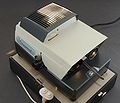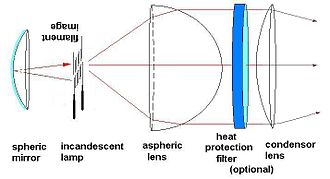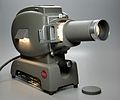Slide projector
A slide projector is an optical-mechanical device with which framed slides are enlarged with light as image projection (image throw) onto a screen, and thus a special projector. It consists essentially of the illumination system with the light source, the imaging system with the lens and the slide holder with the changing system.
· 
Projection lantern with chimney for flame, wooden slide for glass slides, shift lens
·
Leitz-Prado slide projector for manual image change, lateral: operator light
· 
Older slide projector Braun Paximat with cable remote control. Buttons for forward, back
·
Liesegang Fantimat with universal magazine according to DIN 108 to the right of the beam path
Lighting System
The lighting system determines the type of use of a slide projector, which is generally used for darkroom projection (type of projection without ambient light in the projection room) so strong in light that it can usually do without blackout, hence the term "overhead projector". Criteria are the size of the slides, the required luminous flux and the uniformity of the illumination. On the imaging side, the lens with its focal length determines the size of the projected image and the projection distance to the screen. The beam path of the illumination system and the imaging lens form an interwoven beam path.
The illumination consists of the lamp, the concave mirror behind it and the condenser lenses. The light from the lamp shines through the slide and the illuminant of the lamp is imaged in the lens. The lens projects the transilluminated slide onto the screen.
For smaller slides, an ellipsoidal mirror lamp can be used instead of the condenser lens in front of the lamp. Here, too, there is an interlaced beam path and the lamp's luminous body is imaged in the objective.
The illuminant, the lamp has changed considerably from candles, petroleum light, incandescent lamps, halogen incandescent lamps to metal halide lamps. In the course of this development series, the achievable luminous flux (measured in lumens), the luminance of the light source and its colour temperature increased towards daylight. The increase in luminous efficacy, in the case of electrically generated light the efficiency measured in lumens per watt of the generation of light from consumed electrical power reduced the fundamentally undesirable radiation of heat (infrared) from the light source, which heats up the slide by absorption. Already the inevitable absorption of visible light, especially at the dark parts of the slide and the frame, leads to a heating of the slide, incoming heat radiation (high temperature) is also absorbed and heats up the slide. Simple incandescent lamps emit only about 5% of the electrical power as visible light, 95% as heat. Part of the heat is dissipated by thermal conduction (via the socket and connecting wires), another part by convection of the ambient air or blown cooling air, the majority radiates outwards through the lamp bulb according to the Stefan-Boltzmann law of the filament.
The energy flux per thermal radiation is even with metal halide lamps still higher than the per portion of the visible light. Slides are made of plastic (or glass) and usually gelatin (the photographic layer) and therefore have limited temperature resistance, as do frames made of plastic or cardboard. In glassless slide frames, the film material is not held flat and, when irradiated on one side, curves towards the lens after typically a few seconds in the middle of the image, since essentially the side facing the lens with the photolayer absorbs light and heat radiation and this side gradually heats up to a higher temperature.
Various strategies are used to reduce the heat radiation to the slide:
- Heat protection filters in the beam path (after the lamp, just before the condenser) selectively absorb thermal radiation (and as little as possible of the visible light). Originally a water-filled glass cuvette was used, later glass filters, typically 5 to 10 mm thick and with a slightly greenish tint. Effective heat protection filters heat up strongly according to their high power consumption and are cooled by air convection or blower air.
- Infrared-transmissive dichroic mirroring of the collecting mirror behind the lamp, possibly also integrated into the lamp bulb itself, can allow almost half of the relevant heat radiation to escape to the rear.
- Conversely, in more recent times, a differently designed dichroic mirroring of the condenser lenses selectively wipes infrared radiation from the beam path of the projection.
- The inside of the optical housing around the light source and beam path is matt and black coated to absorb scattered radiation (light and infrared) as well as possible. This wall is usually made of metal to conduct the generated heat to the outside and often has light-tight louvre slits to allow cooling air to pass through. If enclosures are made of cast aluminum, they also act to conduct heat across the surface and use the entire surface as a cooling surface. An air space under the housing also serves to improve cooling through draught.
All elements of the beam path, including the slide, are cooled in parallel by a fan that is as quiet as possible. Strong blowing of the lens is not necessary, because it is located at the cold end and because dust deposits are particularly undesirable here.
A small amount of ultraviolet in the light, which would have a particularly strong bleaching effect on color pigments, is easily absorbed by the glass elements (heat protection filters and condenser lenses).
Housings for projectors without blowers tended to be built higher to achieve a favourable chimney effect. Projectors with light from flames have typically small chimneys. Their bell-shaped top serves to avoid flammable laminar high flow of hot exhaust gases.

Slide projector 3×3 cm with ellipsoid mirror lamp, without condenser lenses

Illumination system of a slide projector: Left: concave mirror to increase the amount of light; lamp; right: condenser, 2 lenses, heat protection filter in between; slide (not drawn; its holder is usually located shortly after the right condenser lens).
Projection lens
The projection lens is used for optical-geometric imaging of the projection original on the screen. It is generally made up of 3 to 5 lenses in order to correct aberrations to a large extent.
The lenses are designed with a fixed focal length or with an adjustable focal length as a vario lens. Other versions are shift lenses and the CF lens (Curved Field), adapted to the curvature of a slide not framed between glass, which has heated up during projection.
When changing the focal length of the lens, the image field lens can be changed or inserted in a different position in the lamphouse to adjust the interlaced beam paths.
For focusing, the lens must be movable in the optical axis, for example by means of a coaxial threaded guide.
The resolution describes the property of lenses to separate closely spaced details. It is generally measured in the image in line pairs / mm, test characters according to DIN 19051, or by the modulation transfer function (MTF) or contrast transfer function.
Questions and Answers
Q: What is a slide projector?
A: A slide projector is a device used to view photographic slides using optical and mechanical methods, including an electric light bulb, focusing lenses, reflector and condensing lenses, and a holder for the slide.
Q: What is the purpose of the flat piece of heat absorbing glass in the slide projector?
A: The flat piece of heat absorbing glass is placed between the condensing lens and the slide to avoid damaging the slide by absorbing infrared.
Q: What happens when light passes through the slide and lens in the slide projector?
A: The light passing through the slide and lens result in an enlarged image projected onto a screen that the audience can view.
Q: What is a translucent "rear projection" screen and how is it used with slide projectors?
A: A translucent "rear projection" screen is a screen that is used for continuous automatic display for close viewing. The image is projected onto the screen from behind and the projection avoids people who look at the show interrupting the light stream or bumping into the projector.
Q: What was the common use of slide projectors in the past?
A: In the 1950s and 1960s, slide projectors were commonly used as a form of entertainment. Family members and friends would gather to view slideshows.
Q: What has largely replaced in-home photographic slides and slide projectors?
A: Low cost paper prints, digital cameras, DVD media, video display monitors, and digital projectors have largely replaced in-home photographic slides and slide projectors.
Q: Is it easy to find photo processors who will process slide film in all countries today?
A: It is increasingly difficult in some countries to locate photo processors who will process slide film.
Search within the encyclopedia

